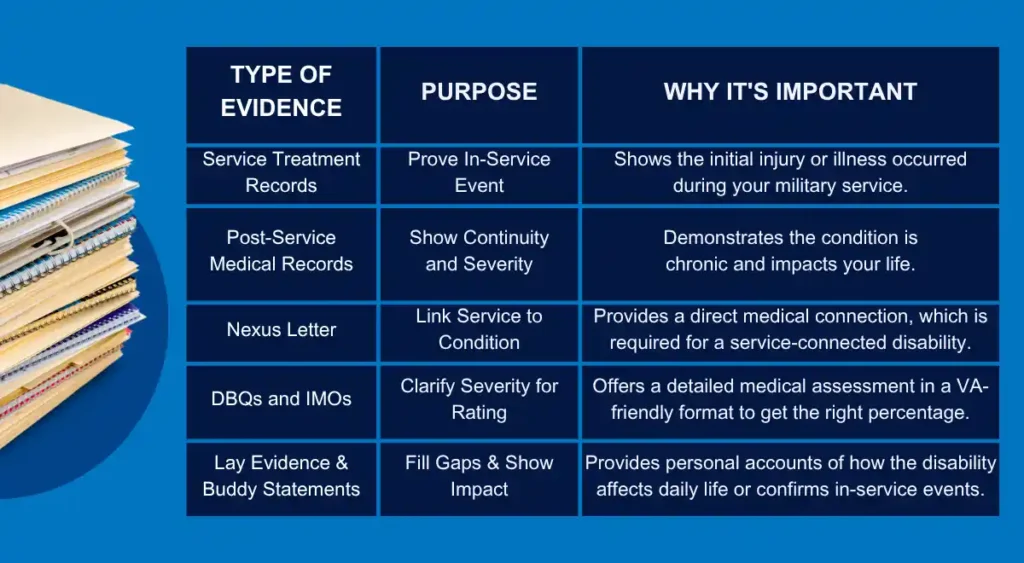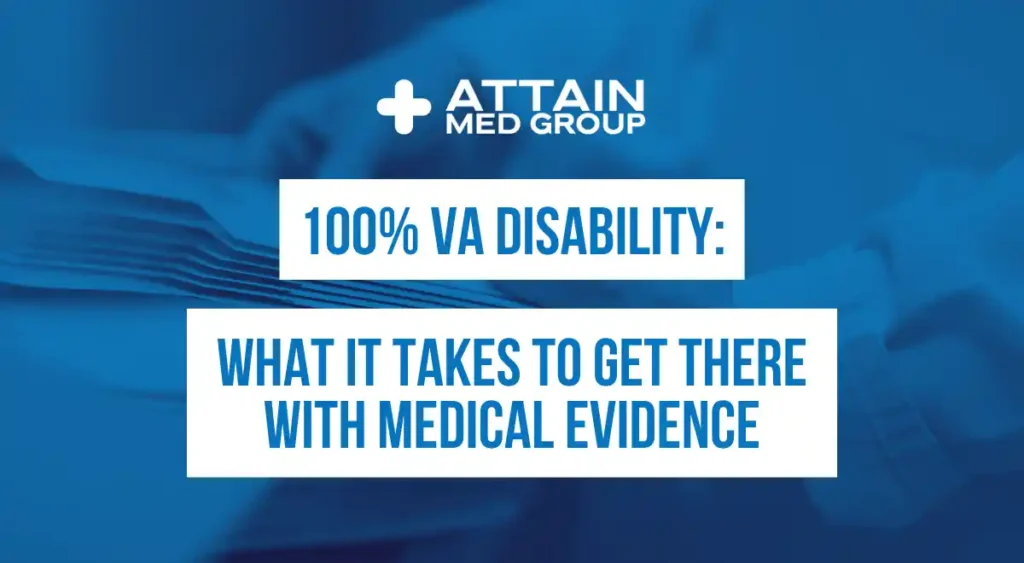You’re aiming for a 100% VA disability rating. You know it’s what you deserve for your service-connected conditions, but the path feels confusing. Getting there depends almost entirely on one thing: the right medical evidence needed for 100% VA disability and how AMG can support that journey with evidence.
You have likely heard stories from other veterans, some good and some bad. The difference often comes down to the quality of the disability benefits claim file they submit. Let’s clear up the confusion and outline a clear path forward.

What Does a 100% VA Disability Rating Really Mean?
A 100% VA disability rating is the highest schedular rating a veteran can receive for their disability benefits. It signifies that the VA has determined your service-connected disability prevents you from maintaining substantially gainful employment. This rating provides the maximum level of monthly compensation and other critical VA benefits.
These benefits are vital for many veterans and their families. They can include comprehensive health care, educational benefits for dependents through Chapter 35, and property tax waivers in some states. Reaching this VA disability rating recognizes the serious impact your military service has had on your health and quality of life.
Veterans can also achieve a 100% rating through a different path called Total Disability based on Individual Unemployability (TDIU). This is for veterans whose ratings don’t combine to 100% but who cannot work because of their conditions. This route also requires strong medical evidence proving your inability to maintain a job.
The Cornerstone of Your Claim: Solid Medical Evidence
Think of your VA disability claim as building a house. Without a solid foundation, the entire structure is at risk. For your benefits claim, that foundation is your medical evidence.
The VA needs definitive proof to approve a service-connected disability. They look for three key elements. You need a current diagnosis from a medical professional, documented evidence of an event or injury in service, and a clear link connecting the two.
This connection, often called a medical nexus, is where many claims fail. It’s not enough to say you hurt your back in the service and your back hurts now. You need one of your health care providers to explain how the current problem is medically linked to that specific service event, which is why strong medical opinions are so important.

Medical Evidence Needed for 100% VA Disability
Gathering all the right paperwork for your disability claim can feel like a full-time job. Knowing what the VA is looking for can make the process much smoother. Different types of evidence serve different purposes in building your case for a 100% rating.
Service Treatment Records (STRs)
Your Service Treatment Records (STRs) are one of the most important parts of your file. These are your official military medical records. They document any injuries, illnesses, or symptoms you reported while on active duty.
These records create the timeline and prove the in-service event occurred. Did you go to sick call for back pain after a training exercise in the Air Force? That entry in your records medical file is invaluable for your disability claim.
Even small complaints noted in your STRs can become the starting point for a major claim down the road. This official evidence is the first thing a VA rater looks for when establishing the history of a condition.
The Benefits Delivery at Discharge (BDD) Program
For a service member filing a claim, the Benefits Delivery at Discharge (BDD) program is a valuable option. If you are a service member still on active duty, you can submit your claim between 180 to 90 days before you separate. This allows the VA to start reviewing your records medical history and schedule exams before you even become a veteran.
The BDD program often uses your completed separation health assessment as a key piece of evidence. This separation health document is a comprehensive medical evaluation done right before you leave the service. It provides a final snapshot of your health while on active duty, which can be critical for connecting conditions to your service.

VA and Private Medical Records
Your medical history did not stop when your military service ended. All your medical records after discharge are just as important. These documents show the VA that your condition is ongoing and has affected your life over time.
Consistent treatment shows a pattern of chronic disability. If you have been seeing doctors for a condition for years, it demonstrates the problem is serious and persistent. These records help establish the severity of your condition, which directly impacts your disability rating percentage.
Make sure you gather all records from VA hospitals, private doctors, chiropractors, and physical therapists. Every note, diagnosis, and treatment plan helps paint a complete picture for the VA rater. The more additional evidence you can provide, the more accurate your final VA disability rating will be.
The Nexus Letter: Connecting the Dots
A Nexus Letter is a powerful tool in your evidence arsenal. This is a medical opinion from a qualified doctor that directly connects your current condition to your military service. A strong nexus letter can be the single most important document you submit.
A good nexus letter does more than just state a connection. The doctor will review all of your records and explain their medical reasoning for why your condition was at least as likely as not caused or worsened by your service. This specific language meets the VA’s standard of proof.
The doctor should cite medical studies or journals to support their opinion. This gives their professional opinion incredible weight. A well-written nexus letter is often the missing piece that turns a denied benefits claim into an approved one.
Independent Medical Opinions (IMOs) and DBQs
Sometimes, the exams the VA provides, called Compensation & Pension (C&P) exams, do not capture the full scope of your disability. The examiner may be rushed or may not be a specialist in your condition. This is where getting your own Independent Medical Opinion, or IMO, can make a huge difference.
An IMO is a medical evaluation from a private doctor who thoroughly reviews your situation. They can fill out a Disability Benefits Questionnaire (DBQ) on your behalf. A DBQ is a specific VA form that care providers can use, so it presents the information in a format the VA rater easily understands.
Submitting a well-written DBQ from a specialist can greatly help your claim. It provides the VA a clear medical summary that shows the true severity of your symptoms. This often leads to a more appropriate disability rating and can sometimes prevent the need for a C&P exam altogether.

Lay Evidence and Buddy Statements
Official evidence isn’t the only thing you can submit. Lay evidence, including personal statements or a buddy statement, can be incredibly persuasive. These are written statements from you, your spouse, family members, or fellow service members who can attest to your condition.
A buddy statement can corroborate an event in service that was never documented in your STRs. A statement from your spouse can describe how your PTSD affects your family life and ability to work. Your own statement can explain a gap in treatment or describe the daily pain and limitations you experience.
Challenges with Official Records and How to Overcome Them
Sometimes, the evidence needed is hard to find. A common issue for many veterans is incomplete or missing service treatment records. This can be especially true for older veterans or those whose records were affected by the 1973 fire at the National Personnel Records Center (NPRC) in St. Louis.
If you discover that St. Louis destroyed records held for your service period, do not lose hope. The VA is aware of this event and has procedures to reconstruct files. This is a situation where lay evidence and a buddy statement become absolutely critical to your claim evidence.
By providing sworn statements from those who served with you, you can help recreate the circumstances of your injury. Detailed personal statements describing the event and subsequent medical issues also carry significant weight. Combining this with strong post-service medical records and a nexus letter can bridge the gap left by the destroyed records.
How Your Total Rating is Calculated
Getting to a 100% VA disability rating often involves combining ratings for several different conditions. The VA uses a special method, often called “VA Math,” to calculate your total rating. It is important to understand that ratings are not simply added together.
For example, a 50% rating and a 30% rating do not equal an 80% rating. The VA starts with 100% (representing a whole person), subtracts your highest rating (50%), leaving you 50% “healthy.” The next rating (30%) is calculated from the remaining 50%, which is 15%. Your combined rating would then be 50% + 15% = 65%, which the VA rounds to 70%.
Because of this complex calculation, you need strong medical evidence for every single condition you are filing a claim for. Each piece of evidence helps secure a rating for an individual issue. All those ratings are combined to bring you closer to the 100% total you deserve, which may include attendance benefits for those who need daily assistance.
How AMG Helps You Build Your Case
Knowing what evidence you will need is one thing; successfully gathering and presenting it is another. The process can feel overwhelming, especially when you are already managing your health issues. This is where getting support from a veterans service organization can be a game-changer.
AMG was founded by veterans to help other veterans. We understand what you are going through because we have been there ourselves. Our team can review your case and help you figure out what medical evidence is missing from your file.
We help connect you with a network of independent medical professionals. These doctors understand the VA system and can provide the nexus letters, IMOs, and DBQs needed to strengthen your claim. We help you take the guesswork out of building a fully developed disability benefits claim so you can focus on your health.

Conclusion
Pursuing a 100% VA disability rating is a marathon, not a sprint. Your success hinges on the quality and completeness of your medical evidence. You must clearly show the VA your current diagnoses, the events in your service, and the undeniable link between them.
This journey can feel complicated, but you do not have to walk it alone. Understanding the medical evidence needed for 100% VA disability and how AMG can support that journey with evidence makes all the difference. With the right proof and the right team supporting your disability claim, you can secure the VA benefits you earned through your service.

